Carnival, Processions and Parades - Interview Claire Tancons
MASSIMILIANO SCUDERI: For many years your artistic research has centred on the paradigmatic concept of Carnival applied to art. Can you better explain what are the reasons and the cultural origins for choosing this field? Does it have something to do with the idea ofmétissage of Modernist and Post-Modernist western culture?
CLAIRE TANCONS - I see Carnival not so much as a domain of application of art, but as art itself. I have been researching Carnival in the Americas from Trinidad to Brazil since 2004, currently, from New Orleans, the home of Mardi Gras, where I live and work, and I have come to consider Carnival as the Americas’ as-of-yet undiscovered Modern Art. This is more than a provocation playing on the colonial idea of the Discovery of the New World. It is rooted in the belief that, as eloquently phrased by Sylvester Ogbechie (Ben Enwonwu: The Making of an African Modernist (Rochester U Press, 2008, p7) Western and non-Western “contexts owe their canonical forms to reciprocal appropriations engendered within an international context of modernity.” I am specifically interested in framing Carnival in its Modern, New World, incarnation following its disaffection from Europe as a mainstream form of popular entertainment and its transplantation in the Americas at the time of the Enlightenment which accompanied European colonization. I have found great recourse in Jonathan Crary’s definition of 19th century Modernism as having operated a “suspension of perception” (Suspensions of Perception Attention, Spectacle, and Modern Culture. The MIT Press, 2001) and see Carnival in the Americas as a “re-possession of perception” whereby unlike in Europe, where the sense of vision was emphasized to the detriment of all other senses, in the Americas, at least in Carnival, all the 5 senses remained part of the experience of Art, and the 6th sense called in as well through spiritual possession.
In regards to the term “métissage”, I am wary of its biological connotations and tend to prefer the term Creolization which, in my view, describes more appropriately what is first and foremost and can only be truly appreciated as a cultural process. In light of my quote from Ogbechie, you will understand that I consider Modernism as inherently inter- or cross-cultural be it in Europe or the Americas. So rather than seeing my project on Carnival has a project concerned with “métissage”, I see it as concerned with Modernity.
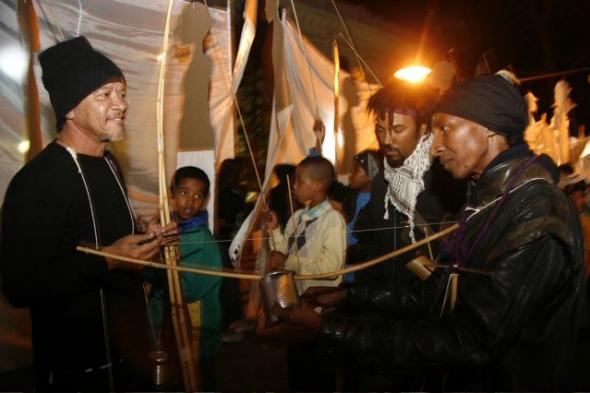 Akiko Ota
Akiko Ota
Do the Carnival-inspired parades you have organized come about as forms of protest from a condition of repression in some cultures?
I have organized two processions inspired by Carnival. The first, called Spring, for the opening of the 7th Gwangju Biennale, in Gwangju, South Korea, on September 5, 2008 and the second, A Walk into the Night, for the opening of CAPE09, the second biennial in Cape Town, South Africa, on May 2, 2009. Springwas inspired by the May 18 Democratic Uprising of 1980, student-led protests that led way to the democratization of South Korea. It took place around the May 18 Democratic Square, the very location where the uprising took place 30 years ago, and was conceived with and performed by students, the symbolic descendants of their precursors who fought and died on these very grounds. A Walk Into the Nightmade reference to the Apartheid-era Forced Removals which dislocated non-white populations from the centre of the city to its outskirts, in what have since become townships. It took place in the Company Gardens (the gardens of the Dutch East India Company) and staged the symbolic return of these populations with 100 participants, most of whom participants in the Cape Town carnival which is historically a tradition of the Coloureds.
My seeming undifferentiated use of the words Carnival and protest came under scrutiny at Bocconi University last year where I spoke about my work in the seminar of Luca Martinazzoli at the invitation of Andrea Lissoni, curator of Arto Lindsay’sMultinatural (Blackout) parade at the 53rd Venice Biennale. This forced me to specify the location of my research on Carnival and the source of my inspiration for my work in processions in the Americas where the two, Carnival and protest, are intimately linked. Carnival was used as a means of covert and at times overt rebellion under the disguise of the mask and the pretext of merriment. One of the best examples of this are the 1881 Canboulay riots in Port-of-Spain during which Trinidadians used Carnival to fight against the British colonial power. Marlon Griffith, an artist from Trinidad who contributed to Spring, took inspiration from the Canboulay riots in his work Runaway/Reaction (2008) to draw a comparison with the May 18 Democratic Uprising. A more recent example is the mass-protests that took place in Guadeloupe (where I was born and grew up) in 2008. The unmistakable high-paced, military-style of marching of Guadeloupean Carnival groups such as Akiyo was applied to the street demonstrations as were the resistance songs of the Guadeloupean Carnival used to convey political slogans. Carnival that year was cancelled for fear of further disruptions in an already highly explosive social and political context of widespread unrest.
What I hope Spring and A Walk Into the Night conveyed is how political and cultural resistance are intertwined and played out in such artistic practices as Carnival and other forms of public festivals. So that Spring and A Walk Into the Night could be seen as celebrating a form of cultural resistance carried out through artistic practices often seen as marginal but which are, in fact, at the core of crucial societal debates.
- In a conversation with Daniel Birnbaum, Sarat Maharaj speaks about Stuart Hall and his capacity to talk in Great Britain about “the invisible colonial subject now present in the heart of the old empire”1. Do you find the sense of these words in your work, and can your approach be considered a sort of “culture switch”?
That invisible colonial subject of whom Stuart Hall speaks was, for instance, a subject of Britain’s Caribbean colonies, be it Trinidad, Grenada or Jamaica, involved in the so-called Notting Hill riots. There again, Carnival was at the centre stage of political and cultural resistance. As you may know the London-based Trinidad Carnival-inspired Notting Hill Carnival, which has become a Pan-Caribbean Carnival over the years and is now recognized as a national festival in the UK, was the stage of violent protests, referred to as riots in the media, between the Carnival’s young black revellers and London’s policemen. This event, and other issues related to retro-colonization or colonization in reverse, was commemorated by filmmaker Isaac Julian in Territories (1984) whose other work is very much concerned with the project of “creolizing vision”.
If my work is about bringing visibility to invisible subjects, then it aims to do so with the artistic tools and cultural strategies of these subjects, Carnival being one of them as well as other forms of popular resistance. I am more interested in empowering communities from within their cultural practices rather than by legitimizing these through appropriation by the mainstream. My interest being in New World Carnival and their diasporic counterparts in North America and Europe, I find the street context and the processional format more relevant than the museum institution and the exhibitionary complex. In that sense, if you will, my work does operate a “culture switch” based on the terms of the culture whose interest it seeks to serve.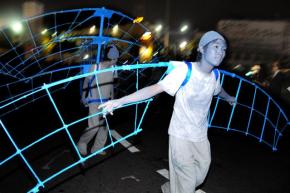 Akiko Ota
Akiko Ota
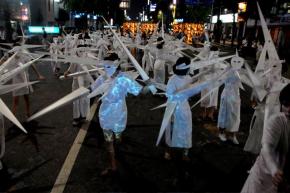 Akiko OtaTalking with Vito Acconci in Rome, during the latest American elections, we wondered what the result of the creolisation of western culture could be, and if the advent of Obama could favour the success of this new cultural trend. What do you think about this question? Is something happening, in this sense, in America?
Akiko OtaTalking with Vito Acconci in Rome, during the latest American elections, we wondered what the result of the creolisation of western culture could be, and if the advent of Obama could favour the success of this new cultural trend. What do you think about this question? Is something happening, in this sense, in America?
The debate over Creolization, what it means and entails, was in my view best summarized in Okwui Enwezor’s Créolité and Creolization’s Documenta 11 Platform (2001). Like Martinican poet Édouard Glissant and in contrast with Stuart Hall who locates the Creolization process very specifically within the historical and geographical context of the Black Atlantic, I believe that the world was undergoing processes of creolization that far predated European colonization and its aftermath in The Americas. In that sense Western culture is a Creole culture and as concerns France, for instance, making parallels with linguistic development in Literature, Glissant advocates for Rabelais as the father of the French language as a Creole language and of French culture as a Creole culture from then on, although, and paradoxically, those who bypass the processual nature of cultural shifts, would appropriate the achievement of an ongoing process of cultural accretions in nationalistic terms.
So, Creolization is not new. It may sound new in the US as a trend but that’s largely erroneous, particularly from the vantage point of New Orleans which is possibly one of America’s most diverse cities, culturally closer to the Caribbean than to North America, although unmistakably shaped by the US’s segregationist history and racial bias. President Obama crystallizes the hopes and fears of those who are on either side of the multicultural line. To me however, his ability to shape a new vision for America has less to do with his much-debated multiracial heritage which, in itself, does not imbue him with special insights, as it does with his humanist outlook on the world beyond North America’s shores. For now, events such as the Tea Parties in Washington, seem to indicate more of a backlash than a progress in regards to a more integrated view of society in the US
Among the many initiatives to which you contributed was Prospect.1 New Orleans, the New Orleans Biennial. As is known, the Biennial also came about with the aim of relieving an affected community with major difficulties. Can you tell me about the project and the repercussion on the territory and on the community itself?
Prospect.1 (November 1, 2008 - January 18, 2009) was conceived by Dan Cameron in the aftermath of Hurricane Katrina (2005) to foster economic re-development by way of cultural tourism, of which the biennial is one of the trendiest tools among the culturati. I was the Associate Curator of the biennial. Though the biennial has been celebrated for its popular and critical success backed up by high numbers both in terms of economic revenue (estimated at 20 million at the highest) and audience attendance (oscillating between 89,000 according to the June 2009 audience survey and 42,000 according to a November 2009 Prospect.1 press release), there is room for debate as to the actual impact and relevance of the event in and for New Orleans. The audience survey (publicly available on the website of Contemporary Arts Center New Orleans) revealed that 83% of its audience, local and non-local was white, while only 11%, 8% local and 3% non-local was black. Considering that New Orleans, despite the flight of a significant portion of its black population following Hurricane Katrina, remains a predominantly black city with 62% of its population being black, the proclaimed success of the biennial is mitigated by its poor attendance numbers in the local black population. Similarly, though New Orleans Parish boasts one of the highest numbers of black-owned business in the US (27,6% in the versus 5.2% nationwide—All population numbers are from the 2008 US Census Bureau available online) I am curious to know how many of the stated millions if any benefited to them. I am not an economist but do understand that there are indirect benefits that may trickle down from jobs maintained or created within a wider scheme of positive economic gain. However and has we know, it is New Orleans black and impoverished black communities who suffered most and most durably from Hurricane Katrina though there were losses amongst all communities. So to me, this begs the question: What exactly was Prospect.1’s vision of “the city”, whom precisely was it supposed to benefit artistically and economically post-Katrina and what means did it devise to reach out to a diverse population?
These are complex and vexing questions that cannot be easily answered. They can, however, easily be dismissed as naive. Indeed, and although I do not know worldwide biennial statistics, I do understand that Prospect.1’s numbers followed general art world trends. It also bucked them in significant ways: the biennial was free of attendance and its 83% white audience, although well-educated (following the general trend) also tended to be younger and less wealthy (contrary to the general trend). Though diversity was not one of Prospect.1’s stated goals (most of which were of artistic and economic nature) it did attempt to reach out to a black audience through venues such as the McKenna Museum for African-American art, the New Orleans Museum of African American Art and the Lower 9th Ward. The Lower 9th Ward is a blue collar African-American neighborhood that was amongst the most affected by the Hurricane and has been the site of various re-building experiments such as Brad Pitt’s much publicized Make it Right initiative which provides green housing designed by world-renown architects to the neighborhood right outside where the levees broke where houses were not just destroyed but washed away by the floods, literally wiped out. Though on a much smaller scale, Prospect 1. did contribute directly to the re-building effort with Mrs. Sarah’s House, a project by one of its 81 artists (of whom 15 exhibited in the Lower 9th Ward), Wangechi Mutu. Ms. Mutu conceived a three-phase project designed to help Mrs. Sarah to re-build her house. Phase 1, in Mutu’s words was meant as “a site sensitive work that will be built as a tribute and a place of pilgrimage for Prospect 1 visitors and especially people of the Lower Ninth”. It consisted in a “ ‘light-drawing’ [which created] a kind of ghost building at night…a mirage of sorts, an attempt to describe [Mrs. Sarah’s] and others’ dreams of returning home” “using the footprint of the house Mrs. Sarah never [re-]built, as a pedestal, building a frame that resembles a traditional New Orleans railroad building where the viewer can visit, enter and walk through” (Artist statement, 2008). For Phase 2, Ms. Mutu made a print called “Home”, the sale of which was used to create a fund and help-fundraise for the re-building of Mrs. Sarah’s House. Phase 3 happened just a couple of weeks ago when, the house having been rebuilt, it was unveiled and inaugurated in a public ceremony on April 11, 2010.
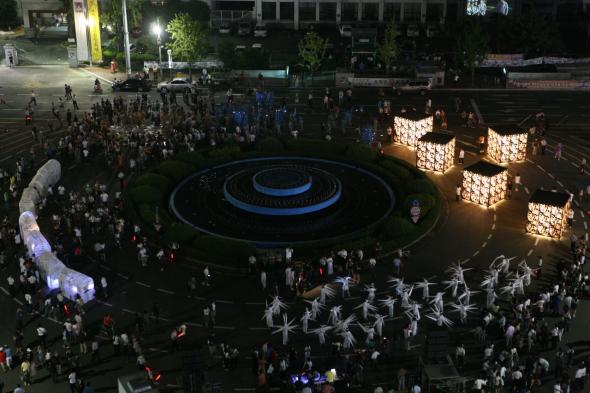 Cheolhong Mo, Courtesy Gwangju Biennale Foundation.
Cheolhong Mo, Courtesy Gwangju Biennale Foundation.
Last year the city of L’Aquila in Italy, as well as recently New Orleans and Haiti, underwent a catastrophic natural event, a strong earthquake that brought it to its knees. In your opinion, can art and culture in general revive the sense of identity of a community beset by such events? Has this happened, for example, in New Orleans?
I think that it takes time to register the impact, cultural and economic of such events, provided they can be sustained, which has yet to be demonstrated with Prospect. In general, I am skeptical of claims made on behalf of populations, particularly in culturally disenfranchised and economically impoverished locations such as New Orleans or Haiti. I also do think that there can be legitimate concerns about the neo-colonial nature of the worldwide biennial trend, which tends to impose a Western cultural model as mainstream in non-Western locales the artistic practices and cultural heritage of which often belie the notion that contemporary art is a globally shared cultural value. To go back to New Orleans, I wonder the extend to which the general public, black and white, really felt concerned with the works on offer? As concerns the black population whose cultural traditions emanate in great part from the so-called Social Aid and Pleasure Clubs and take the public form of various ephemeral, processional public displays during Carnival, Second-Line parades and Jazz Funerals, I wonder if museum-sanctioned “contemporary art” did have an impact at all? I also wonder the extent to which these culturally black artistic practices which were featured in Prospect New Orleans such as the exhibition of Mardi Gras Indian Victor Harris (which I organized) were more than mere tokens of appreciation of black culture thrown in the mix of an otherwise predominantly white cultural event in a predominantly black city. The question also is Who speaks from where, for whom and to what ends? And I think that biennials often do a lot of cultural ventriloquism whereby they speak of the benefits supposedly earned by the populations of the locales in which they take place for these local populations, having defined in advance what was good for them according to an agenda that can be far from local aspirations and goals. I look forward to learning more about cultural initiatives waged in L’Aquila to bring relief from the earthquake and ways in which it will depart or not from already established models.
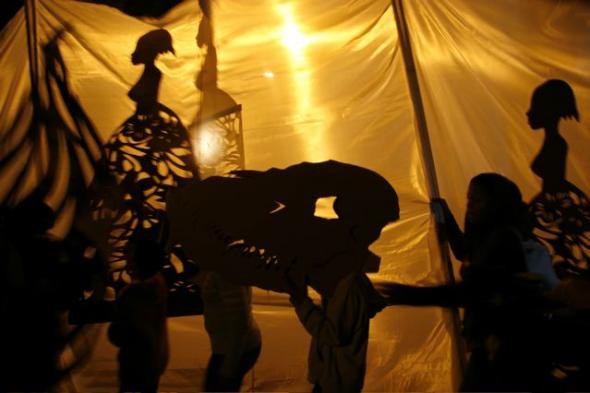 'A Walk Into the Night', 2009, CAPE 09, Cape Town, South Africa. Photo by Mark Wessels
'A Walk Into the Night', 2009, CAPE 09, Cape Town, South Africa. Photo by Mark Wessels
- What are your upcoming projects?
I have just completed research travels in over 20 countries mostly in Southern and West Africa, as well as in Western Europe, Latin America and the Caribbean over the last 12 months. My travels aimed at expanding my field of research from the Americas out into the wider Black Atlantic context and from Carnival to other masquerade and processional traditions against the backdrop of global protest movements. So that I looked as much at São Tomé’s Tchiloli as I did Carnival in Luanda, Angola and Mindelo in São Vicente, Cabo Verde, as performance art in Lagos, Nigeria, and anti-capitalist so-called Konsumprocessions in Munich. I am now working on developing my research into two related projects. One is an institutionally-based, traveling project slated to debut at CAC New Orleans in 2013, the provisional title of which is Carnival: Art to and from New Worlds and which aims is to encompass contemporary artistic practices within Carnival as well as the current contemporary art trend in parades and processions which I see as indirectly related. It will take place inside the museum and outside with an exhibition, workshops and processions. The other is a book project, tentatively called Carnival, Procession and Protest. Art, Agency and the Re-Possession of Perception. It builds an argument about Carnival in the Americas as a modern art form which, unlike 19th century Western modernism defined by Jonathan Crary as a “suspension of perception” privileging vision, operated a re-possession of perception through pan-sensorial experiences.
I have also started to work towards the first edition of Harlem Biennale, a biennial for and from Harlem, the prominent upper-Manhattan neighborhood, slated to open in the Spring of 2012. I am looking forward to using the experience acquired in New Orleans in Harlem, both of whom have strong black cultures and face similar challenges, notably in the face of gentrification. The approach of Harlem Biennale so far has been a bottom-up approach rooted in the local communities with local and international advisory committees working collegially on all matters curatorial, educational etc., an approach likely to encourage self-sustainability in the long term that is also challenging in the short term notably in terms of fundraising. I am particularly excited by the fact that, in keeping with Harlem’s street-oriented popular culture, Harlem Biennale has asked me to design a model for a recurring procession event that, from Marcus Garvey’s UNIA parades of the 1920’s to the first Harlem Carnival in 1947 taps into Harlem’s rich history in…Carnival, processions and protests.
Interview by Massimiliano Scuderi to Claire Tancons
in Arte e Critica, n°63 - Junho/Julho 2010.
- 1. Sarat Maharaj, Philosophical Geographies in Making Worlds/Fare Mondi (catalogue of 53rd Venice Biennale), ed. Marsilio, 2009